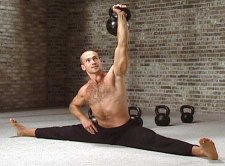How to Isometrically Stretch
Double Your flexibility in Minutes
By Paul "Batman" O'Brien
B.A., N.C.E.H.S., Dip. Acu., Cert Clin. IMed., Dip. Adv. OBB, Dip. CHM, Pn1, PN-SSR, PN-NCA, M.AFPA., M.C.Th.A.
How to Isometrically Stretch? It's question I get asked a lot. And the reason? Isometrically Stretching is by far the most effective and safe method for increasing the range of motion of your joints. In fact -
Isometric Stretching is documented to be OVER 267% more effective than conventional relaxed stretching!
In this article I'm going to give you a simple guide to some isometric stretches and I've even filmed a few for you to watch.
Why You Should Be Doing Isometric Stretching
Aside from dramatically increasing your range of motion, how to Isometrically Stretch makes you STRONGER in the weakest of positions. And this is one of the keys to it's success. Your body will only allow you to go to a range it feels it can safely pull you back from. If it doesn't have confidence in your strength it simply will not allow you to go there.
I'll get to how to Isometrically Stretch in a moment, but first....are you familiar with a condition called frozen shoulder?
I see a lot of this in my clinic and have a great success rate in treating it. I bring this up because of an interesting observation that can be made in cases of frozen shoulder that directly relates to flexibility.
In the case of a frozen shoulder, a person loses their range of motion and ability to articulate and move the shoulder joint. Here’s the interesting fact – when someone is conscious and wide awake they can’t move their arm in a full degree if it’s frozen. However, knock that person out and you can move it right around no problem – the reason the shoulder is frozen is because it is WEAK! (Now often that’s because of a slight misalignment of the spine that prevents the muscle innervating).
So, what has this to do with stretching? Simple – Range of Motion has NOTHING to do with flexibility and EVERYTHING to do with strength. Your body will ONLY let you take a position where the muscle can be strong and support itself. Your body WILL not let you put yourself in a position you can’t pull yourself back from. This is regulated by your Golgi Tendinous Organs. It has nothing to do with short muscles or anything else. Flexibility is determined by muscular strength and nervous control. This is a KEY aspect in how to Isometrically Stretch.
How to Isometrically Stretch for the Splits

Pavel Tsatsouline in perfect side splits
The best example of this is the splits. Most people can’t do the splits. Right? They’re not flexible enough, right? Wrong. The muscles of your legs are MORE than long enough to actually do the splits. Seriously – go test it right now. Get out of the chair you’re sitting in, it’s okay, just go do it right now. Great, now place your right foot on the chair, keeping your leg straight. You should have your left leg straight, foot flat on the ground, creating a 90 degree angle. Got it? Cool. Now, do it with the other leg. You can sit back down now.
Most people, except for those who are very de-conditioned and those with anatomical injuries should be able to do that with ease. So why did I make you do that and what has it got to do with how to Isometrically Stretch?
The answer is that placing your leg at a ninety degree angle proves you can do the splits. But, “wait”, you say “I might be able to do it one leg at each time, but there is no way I can pull it off with both legs together to do a 180 degree splits.” It’s my pleasure then to tell you an interesting fact – there is nothing – and I mean nothing that connects one leg to the other. Take a look, both legs slot independently into the hip, no muscle runs across or connects them. Nothing. So why can’t you do the splits?
The blame lies in one of the body’s self-protection mechanisms, primarily the Golgi Tendon Organ or GTO for short. The GTO measures tension in each muscle and how tightly it is contracted. It also creates muscular contraction in response to stimulus. Essentially, as you attempt to do a side split, your body, thanks to the GTO, contracts your muscles, because it’s afraid of injuring itself. Basically, your body doesn’t trust itself and tenses you up, shortening your muscles and preventing you from doing the splits.
In the video below I am going to show you How to Isometrically Stretch for the Splits
How to Isometrically Stretch
I got into this in much greater detail and examine a variety of different variations on these principles in Samurai Strength, but this is the basic framework on how to Isometrically Stretch.
- Place yourself in a stretch at roughly a point at the edge of your comfort zone.
- Take a deep maximal capacity breath (tanden breathing) and tighten up your entire body, especially the target muscles you are about to stretch.
- It helps to think of your body as a fist.
- Make sure you don't cheat yourself and shorten the amount of stretch accidentally when you are tightening up!
- Momentarily, hold your breath, then
- Maximally tense the body, peaking the full body tension for as you breath out for 7-12 seconds making an "SSSSSS" sound, then suddenly let it all out with a sigh of relief.
- Go limp, let it all hang loose, every muscle, every fibre of your being as you softly breath in for 3-4 seconds.
- You will naturally increase the range in the area being stretched. However IMPORTANT - Do not go more than an inch or so at a time, to make your stretches safer.
- Stay in this new longer and relaxed position for awhile before the next contraction (except in the case of forward bending backstretches).
- Repeat 1-9 until you can no longer increase your range of motion.
Obviously this is just a simple outline, and there's a lot more too it, involving breathing methods, different contraction types, intensity levels, length,special positions etc but this is the basic method of how to Isometrically Stretch.
The Next Step...
Now...here's what I want you do next.
- Practice the above how to Isometrically Stretch method every second day for a week. With a few key stretches for your weak area's Take longer to rest and recover if you need it. Remember PAIN IS NEVER GOOD. Don't be an idiot, back off and work at your current level.
- Then come back here and post how you feel after a week below. I'll be looking for your comments and will keep you on track.
- Subscribe to the newsletter - there's a few free e-books, isometric guides and even a few instructional videos for the abs. I'll also be able to keep you up to date with the next article in this series.
- Join the Isometric Facebook fan page. I post tips, motivational posts, techniques, and articles there daily. I also do tons of Q & A's and answer your fitness questions. Say hi! - https://www.facebook.com/IsometricTraining
- Finally, if you're looking for a more comprehensive program or more isometric exercise help check out my Perfect Body system.










New! Comments
Have your say about what you just read! Leave me a comment in the box below.